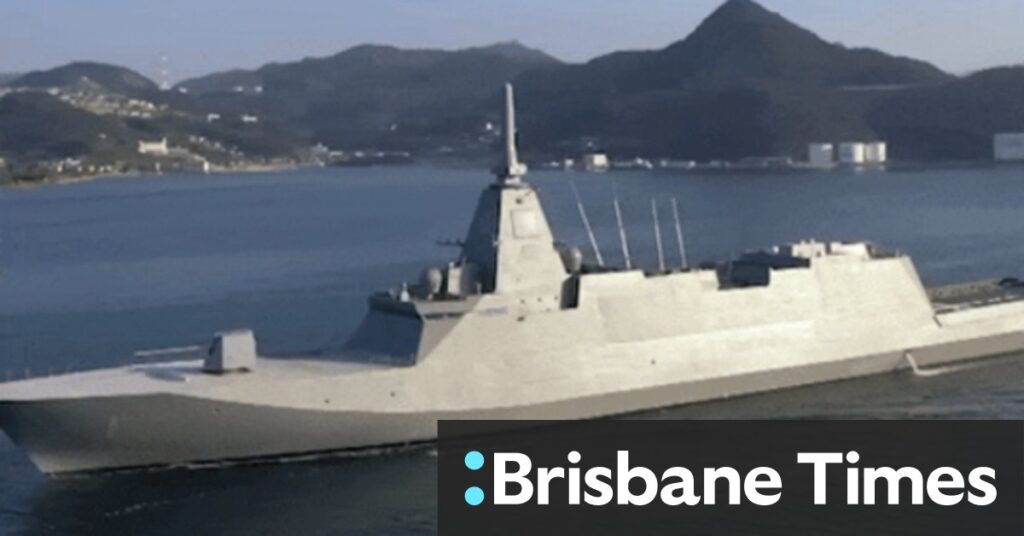
Giant cranes dot the coastline near Nagasaki, the ancient port city in southwestern Japan, renowned for its historical significance as the second city to be hit by a nuclear bomb during wartime. Nestled beneath steep, forested hills, these cranes are a testament to the area’s rich maritime heritage, which began centuries ago when Europeans first made contact with Japan. Next month, a significant event will unfold as Mitsubishi Heavy Industries (MHI) launches one of the Japanese navy’s newest vessels with much fanfare.
This development comes as Australia prepares to invest $10 billion in a new fleet of 11 general-purpose frigates, known as the SEA3000 project. MHI is competing with the German boatbuilder Thyssenkrupp Marine Systems (TKMS) to secure this lucrative contract. Australia’s plan is to quickly acquire these frigates to replace the aging Anzac-class frigates and bridge the gap until the larger Hunter-class heavy frigate arrives in 2032. The Albanese government is expected to decide between the Japanese Mogami and the German MEKO A-200 by the end of the year.
The Mogami Frigate: A Technological Marvel
The Mogami frigate, Japan’s 11th in the series, is a high-tech warship with sleek, smooth surfaces designed for stealth. It will eventually join the Japanese Maritime Self-Defense Force, as the nation’s navy is now known. The ship’s design minimizes radar cross-section by internalizing equipment typically found on deck, giving it a stealth bomber-like appearance.
Commander Atsushi Izumi, who has served on a Mogami frigate, highlighted the ship’s reduced crew requirements due to advanced automation. “When I first started working on the vessel, I noticed a significant reduction in manpower,” he explained. The Mogami requires only 90 crew members compared to the typical 120 needed for other frigates.
Central to this efficiency is the Combat Information Centre (CIC), a nerve center that controls multiple systems, including weapons, fire control, engine, and communications.
Strategic Implications for Japan and Australia
Japan’s interest in exporting defense technology marks a significant shift from its postwar pacifist stance. Article 9 of Japan’s constitution explicitly renounced war, and for decades, the nation was considered pacifist. However, former Prime Minister Shinzo Abe pushed for a more robust military and a “proactive” approach to peace. This led to legislative changes that upgraded Japan’s defense ministry and national security architecture.
Japan’s military has strengthened in response to what Tokyo describes as “the most severe and complex environment since the end of World War II.” China, North Korea, and Russia are identified as key players in this changed security landscape. China is seen as a rapidly expanding military power with territorial ambitions, while North Korea continues its nuclear program and missile activities. Russia is also increasing its military presence in East Asia.
Japan plans to spend 2% of its GDP on defense by 2027, with a five-year defense budget of approximately 43 trillion yen (about $430 billion).
Australia’s Defense Strategy and the Mogami Frigate
Australia’s decision to potentially partner with Japan for the SEA3000 project reflects a strategic alignment with like-minded nations. The first three ships of the new fleet will be built overseas, with the remaining eight constructed in Australia. The first ship is expected to be delivered in 2029.
The upgraded Mogami design for Australia will feature 32 vertical launch system missile cells and accommodate a Seahawk helicopter. The ship’s advanced capabilities, including its stealth design and reduced crew requirements, make it an attractive option for Australia’s defense needs.
Looking Ahead: A New Era in Defense Collaboration
The potential partnership between Japan and Australia represents a significant step in regional defense collaboration. As Japan continues to expand its military capabilities and export defense technology, it positions itself as a key player in the Indo-Pacific region. This collaboration could lead to increased defense coordination and joint exercises, strengthening ties between the two nations.
As the Albanese government prepares to make its decision, the outcome will not only impact Australia’s defense strategy but also signal a broader shift in regional security dynamics. The launch of Japan’s Mogami frigate next month will be closely watched by defense experts and policymakers alike, marking a pivotal moment in the evolving landscape of global defense partnerships.







